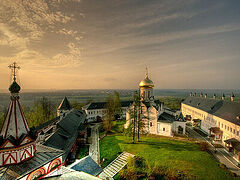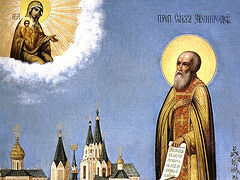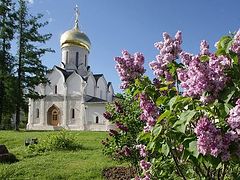The name of St. Savva of Storozhev is associated with many miracles. We will tell you about one of them. It happened during the capture of Moscow by the French in 1812. The French general Eugène de Beauharnais, who headed a 20,000-strong division, occupied Zvenigorod and settled in the Storozhev Monastery.
Appearance of St. Savva to General Eugene de Beauharnais
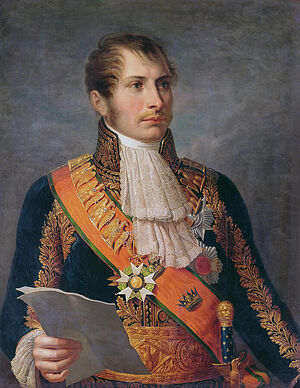 Eugene de Beauharnais Who was this Eugène de Beauharnais, who witnessed a miracle in the monastery he had occupied? A stepson to Napoleon, he was viceroy of Italy and a great military commander. At the end of the eighteenth century, his father, a young officer named Alexandre de Beauharnais, married Josephine, a Creole, who bore him a son in 1781. The child was named Eugène Beauharnais. Alexandre's political and military career came to an abrupt end: He was executed in 1794. His son was thirteen years old at the time. Eugene joined the army at an early age. In 1796, the widowed Josephine de Beauharnais married the then little-known General Bonaparte, who took Josephine's children as his own.
Eugene de Beauharnais Who was this Eugène de Beauharnais, who witnessed a miracle in the monastery he had occupied? A stepson to Napoleon, he was viceroy of Italy and a great military commander. At the end of the eighteenth century, his father, a young officer named Alexandre de Beauharnais, married Josephine, a Creole, who bore him a son in 1781. The child was named Eugène Beauharnais. Alexandre's political and military career came to an abrupt end: He was executed in 1794. His son was thirteen years old at the time. Eugene joined the army at an early age. In 1796, the widowed Josephine de Beauharnais married the then little-known General Bonaparte, who took Josephine's children as his own.
At the age of sixteen, Eugène became an aid-de-camp to Bonaparte. Ever since he made his first steps on the battlefield, he showed courage and bravery. At Bonaparte's side, he participated in the Italian campaign of 1796–1797, the Egyptian expedition of 1798–1801 and other Napoleonic wars. When Napoleon returned to France from his Egyptian campaign in the fall of 1799, Eugène was promoted to captain of the Chasseurs a Cheval. At the young age of eighteen, Eugène de Beauharnais was promoted to the rank of colonel for his bravery in one of the battles of the Italian campaign of 1800. Napoleon said on the occasion: “Eugène is marching fast towards immortality—he has covered himself with glory in all battles.”
Eugène assisted Bonaparte in the coup of 18/19 Brumaire, 1799, which resulted in the establishment of a new French government with Napoleon as its head. Napoleon then became First Consul for life, and finally, in 1804, he declared himself Emperor of the French, and Eugène was called Prince. He accompanied his stepfather everywhere, who valued him for his nobility, frankness, loyalty and military talents.
In 1804, when Eugène was only twenty-two, he was promoted to Brigadier General; in 1805, he was declared Viceroy of Italy and in 1806 he was formally adopted by Napoleon I. On January 26, 1806, Eugène de Beauharnais married Princess Augusta-Amelie, daughter of King Maximilian-August, King of Bavaria. The Italian troops under Eugène's command were of course fighting on the side of Napoleon in his campaign of 1812.
Let’s continue our story about the time General de Beauharnais spent in the St. Savva of Storozhev Monastery. After sleeping through the day, Eugène woke up in the evening and suddenly saw a comely old man in a black monastic clothing entering his cell. Looking at the prince, the monk said softly:
“Do not allow your troops to plunder the monastery, and especially do not take anything from the church. If you do as I ask, God will be merciful to you and you will return safely to your homeland. And may it be known to you that your descendants will dedicate their lives to Russia.”
Having said this, the monk disappeared right away. Eugène was stunned by the vision: the dream was almost real. He immediately made a diary entry about what had happened.
Eugène took the advice of the Russian elder and the next morning gave orders to stay away from the monastery’s property. Entering the cathedral church, he recognized his night guest on the icon of St. Savva of Storozhev. The prince venerated the relics of the saint, sealed the church, and assigned thirty guards to protect it, giving strict orders that no one but the monks should enter inside. All the valuables stolen during the previous night were returned to the monastery by order of the general. This noble act by Beauharnais inspires an even greater respect if we take into account how hundreds of Orthodox churches were laid to waste by the French, or how they set up a stable inside the Dormition Cathedral, the main church of the Moscow Kremlin.
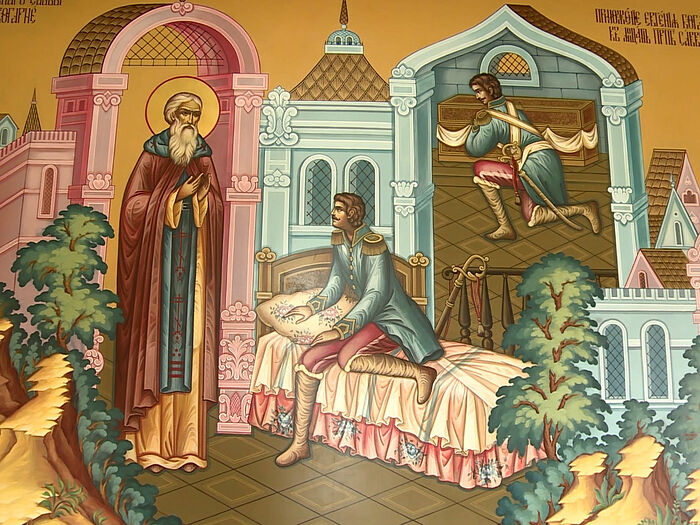 Painting in the church at the village of Anosovo, Smolensk Region
Painting in the church at the village of Anosovo, Smolensk Region
Beauharnais fulfilled the will of St. Savva: The monastery suffered little damage, and the venerable saint in turn also kept his promise. Eugène did come out of it safe and sound, he was never wounded in battle, whereas nearly all of Napoleon’s Marshals were either killed or executed. Ney and Murat were shot, Berthier committed suicide; Bessières was killed at Luetzen; Marshal Duron was also killed in battle. Mortier, who blew up the Kremlin during his retreat from Moscow, was himself blown up in Paris during an assassination attempt on the life of King Louis Philippe. Junot died a madman. Marshal Poniatowski drowned while wounded; Marshal Augereau died of a painful lung disease.
After the fall of Napoleon, the new French authorities valued and respected General de Beauharnais, and the Russian Emperor Alexander I developed such a liking for him that he was at one point in time inclined to put him on the imperial throne as a king of France. But Eugène refused all honors and lived out his life quietly and peacefully in Munich, receiving the title of Duke of Leuchtenberg from his father-in-law King Maximilian Joseph. He had six children. Eugène de Beauharnais died on February 21, 1824 and was buried in the Church of St. Michael in Munich not far from the tombs with the relics of the holy healers Sts. Cosmas and Damian.
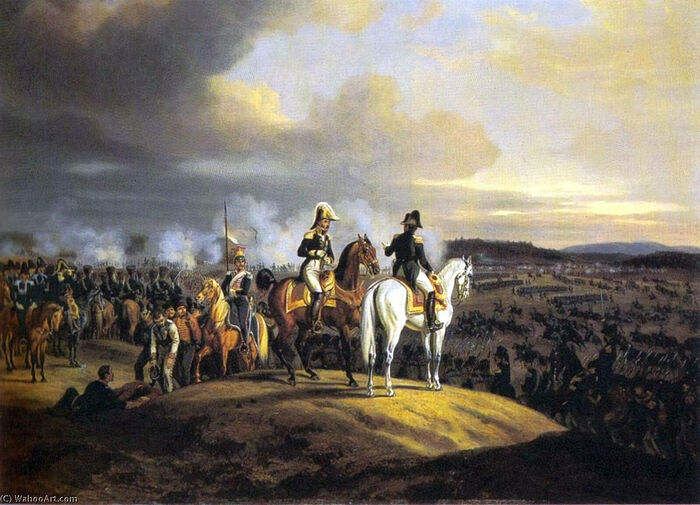 Eugène de Beauharnais and Napoleon in Russia. Artist: Adam Albrecht
Eugène de Beauharnais and Napoleon in Russia. Artist: Adam Albrecht
How the descendants of the Beauharnais came to serve Russia
Throughout his life, Eugène de Beauharnais kept the memory of St. Savva sacred, for it was owing to his intercession that God preserved his life. Soon after the Napoleonic campaign, a chapel dedicated to Venerable Savva was built near Paris, and he became one of the few Russian saints known and venerated in France. Eugène brought up his son Maximilian with reverence for the Russian saint and for Russia.
In 1839, Maximilian, the Duke of Lichtenberg, came to Russia to celebrate the anniversary of the Battle of Borodino. When the military parade on the Borodino field was over, Maximilian, much to the surprise of the Russian side, asked to visit the monastery of Venerable Savva of Storozhev in Zvenigorod near Moscow. Fulfilling the will of his late father, he visited the St. Savva of Storozhev Monastery together with the imperial family and venerated the relics of the saint.
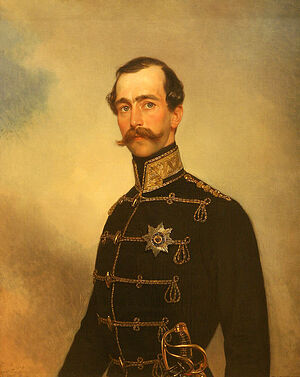 K.P.Brullov. Portrait of Duke Maximilian of Leuchtenberg Soon the young Maximilian married Grand Duchess Maria, the daughter of Russian Emperor Nicholas I. Maria Nikolayevna married for love. She met her future husband in 1837, when he came to St. Petersburg for cavalry maneuvers. A year later, during his second visit, the young couple realized that they could not live without each other. Nicholas I agreed to the marriage of his daughter on the condition that the couple would live in Russia rather than abroad. The wedding took place on July 2, 1839 and followed two rites, Orthodox and Catholic (Maximilian was a Catholic). After the wedding, the newlyweds visited the Storozhev Monastery again and venerated the relics of the saint. Maximilian moved to Russia to live permanently. His family settled in St. Petersburg on Nevsky Avenue in the palace that Nicholas I had built for his favorite daughter. Seven children were born to them. Maximilian was president of the Academy of Arts, head of the Mining Institute, conducted scientific research in the field of galvanoplastics, established a galvanoplastics factory and a hospital in St. Petersburg, and worked on developing a model farm at his Tambov estate. He also took an active part in the construction of the first railways in Russia. Maximilian died of tuberculosis at the age of thirty-five. His descendants lived in their palace on Nevsky Avenue until the October revolution, and the Dukes of Leuchtenberg were fortunate enough to be in Paris when it happened.
K.P.Brullov. Portrait of Duke Maximilian of Leuchtenberg Soon the young Maximilian married Grand Duchess Maria, the daughter of Russian Emperor Nicholas I. Maria Nikolayevna married for love. She met her future husband in 1837, when he came to St. Petersburg for cavalry maneuvers. A year later, during his second visit, the young couple realized that they could not live without each other. Nicholas I agreed to the marriage of his daughter on the condition that the couple would live in Russia rather than abroad. The wedding took place on July 2, 1839 and followed two rites, Orthodox and Catholic (Maximilian was a Catholic). After the wedding, the newlyweds visited the Storozhev Monastery again and venerated the relics of the saint. Maximilian moved to Russia to live permanently. His family settled in St. Petersburg on Nevsky Avenue in the palace that Nicholas I had built for his favorite daughter. Seven children were born to them. Maximilian was president of the Academy of Arts, head of the Mining Institute, conducted scientific research in the field of galvanoplastics, established a galvanoplastics factory and a hospital in St. Petersburg, and worked on developing a model farm at his Tambov estate. He also took an active part in the construction of the first railways in Russia. Maximilian died of tuberculosis at the age of thirty-five. His descendants lived in their palace on Nevsky Avenue until the October revolution, and the Dukes of Leuchtenberg were fortunate enough to be in Paris when it happened.
That's how St. Savva's prophecy that the descendants of Eugène de Beauharnais would serve Russia came to pass.
The descendants of Beauharnais in our time
In 1995, the eighty-year-old Orthodox Nun Elizabeth, a French-born representative of the Beauharnais family, visited the Zvenigorod museum of history, architecture and art. According to her, family tradition had it that Maximilian converted to Orthodoxy.
Currently, all descendants of Beauharnais have Russian names and profess Orthodoxy. They consider the Venerable Savva of Storozhev as their Heavenly patron. Anytime a new family is formed, the couple receives a copy of the icon of the venerable saint that was once presented to Eugène Beauharnais at the monastery.

